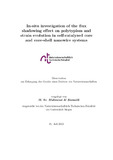Citation link:
http://dx.doi.org/10.25819/ubsi/10170Files in This Item:
| File | Description | Size | Format | |
|---|---|---|---|---|
| Dissertation_Mahmoud_Al_Humaidi.pdf | 35.38 MB | Adobe PDF |  View/Open |
| Dokument Type: | Doctoral Thesis | metadata.dc.title: | In-situ investigation of the flux shadowing effect on polytypism and strain evolution in self-catalyzed core and core-shell nanowire systems | Other Titles: | In-situ-Untersuchung des Flusses Abschattungseffekts auf Polytypismus und Dehnungsentwicklung in selbst-katalysierten Kern und Kern-Schale Nanodraht-Systemen | Authors: | Al Humaidi, Mahmoud | Institute: | Department Physik | Free keywords: | Semicondoctors, Epitaxy, Strain, Nanowires, X-ray diffraction | Dewey Decimal Classification: | 530 Physik | GHBS-Clases: | UIUG UIRK UIUD |
Issue Date: | 2021 | Publish Date: | 2022 | Abstract: | Halbleiter-Nanodrähte mit quasi-eindimensionaler Geometrie haben in den letzten Jahrzehnten große Aufmerksamkeit erlangt. Die einzigartige Geometrie dieser Objekte trägt zu ihren unverwechselbaren optischen und elektrischen Eigenschaften mit vielversprechenden Möglichkeiten für neuartige Bauelemente bei. Die Bandlücke der Nanodrähte hängt von ihren Kristalleigenschaften wie den Kristallphasen und der Verspannung ab, die wiederum in hohem Maße modifizierbar sind. Daher ist die Herstellung und das Studium von Nanodrahtkristallen wesentlich für die Modifizierung und Kontrolle ihrer Eigenschaften. In dieser Arbeit wird eine Molekularstrahlepitaxie-Kammer zur Herstellung von GaAs-Nanodrähten verwendet und die Veränderungen der Nanodraht-Kristallstruktur während des Wachstums als Funktion des Abstands zwischen den benachbarten Nanodrähten untersucht. Die Untersuchung der Nanodrähte während des Wachstums in Arrays mit unterschiedlichen Drahtdichten mittels zeitaufgelöste Röntgenbeugung zeigt eine starke Abhängigkeit der Kristallstruktur vom Nanodrahtabstand. Diese Abhängigkeit wird zum Teil auf den Abschattungseffekt der Materialflüsse zurückgeführt, auf den sich der erste Teil dieser Studie konzentriert. Weiterhin wird die Entwicklung der Gitterverspannung in den Nanodrähten während des asymmetrischen Wachstums einer gitterfehlangepassten InxGa1−xAs-Schale untersucht. Das asymmetrische Wachstum der Schale auf den Nanodrahtfacetten führt zu einer asymmetrischen Variation der Gitterverspannung über den Nanodrahtquerschnitt, die eine Biegung des Nanodrahtes hervorruft. Die über den Nanodrahtquerschnitt variierende Gitterverspannung kann für die Modifikation der Bandlücke sowie der optischen Eigenschaften des Nanodrahtes genutzt werden. Aus diesem Grund wird eine detaillierte Untersuchung der Gitterverspannung und der Nanodrahtbiegung durchgeführt. Die Entwicklung der Gitterverspannung und der Nanodrahtbiegung während des Schalenwachstums wird mit Hilfe von zeitaufgelöste in-situ Röntgenbeugung an einem einzelnen Nanodraht sowie an einem Nanodraht-Ensemble beobachtet. Diese Untersuchung offenbart eine nicht-lineare Abhängigkeit der Gitterverspannung und der Nanodrahtbiegung von der Dauer des Schalenwachstums, was auf Veränderungen derWachstumsdynamik hinweist. Zuletzt wird der Abschattungseffekt der Materialflüsse durch die benachbarten Nanodrähte genutzt um die Verteilung des Schalenmaterials entlang der Wachstumsachse der Nanodrähte zu steuern, was zu einem variierenden Verspannungsfeld entlang derWachstumsachse der Nanodrähte führt. Diese Methode kann für die Modifikation von Verspannungsgradienten und für Bauteile auf Nanodraht-Basis mit neuartigen Geometrien eingesetzt werden. Semiconductor nanowires with a quasi-one-dimensional geometry have gained great attention during the past decades. The unique geometry of these objects contributes to their distinctive optical and electrical properties that are promising for novel devices. The configuration of the band gap of the nanowires depends on their crystal properties such as the crystal phase and the strain which in turn are highly controllable. Therefore, the realization and the study of the nanowire crystal are essential for tuning and controlling their properties. In this work we use a molecular beam epitaxy chamber for fabricating GaAs nanowires and we investigate the changes of the nanowire crystal structure during growth as a function of the interspacing between the neighboring nanowires. By means of time-resolved X-ray diffraction technique, monitoring the nanowires during growth at arrays with different densities shows a high dependency of the crystal structure on the nanowire interspacing. This dependency is partially attributed to the shadowing effect of the growth material fluxes which we focus on in the first part of this study. Further, we investigate the strain evolution in the nanowires during an asymmetric growth of a lattice- mismatched InxGa1−xAs shell. The asymmetric growth of the shell materials on the nanowire facets results in an asymmetric strain variation across the nanowire cross section, which induces nanowire bending. The varying strain across the nanowire cross-section can be utilized for engineering the band gap and the optical properties of the nanowire. Therefore, we perform a detailed study of the strain and nanowire bending. The evolution of the strain and nanowire bending during shell growth is observed by means of time-resolved in-situ X-ray diffraction technique on a single nanowire as well as on a nanowire ensemble. This investigation revealed a non-linear dependency of the strain and nanowire bending to the shell growth time, indicating changes of the growth dynamics. Lastly, we exploit the shadowing effect of material fluxes by the neighboring nanowires to control the distribution of the shell material along the nanowire growth axis, which results in a varying strain field along the nanowire growth axis. This method can be employed for strain gradient engineering and nanowire-based devices with novel geometries. |
DOI: | http://dx.doi.org/10.25819/ubsi/10170 | URN: | urn:nbn:de:hbz:467-22595 | URI: | https://dspace.ub.uni-siegen.de/handle/ubsi/2259 | License: | http://creativecommons.org/publicdomain/zero/1.0/ |
| Appears in Collections: | Hochschulschriften |
This item is protected by original copyright |
Page view(s)
347
checked on Jan 14, 2025
Download(s)
55
checked on Jan 14, 2025
Google ScholarTM
Check
Altmetric
This item is licensed under a Creative Commons License


